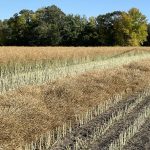HOLDEN, Alta. – The day water restrictions were lifted in the Village
of Holden, the chief administration officer in charge of getting a
water pipeline to her central Alberta community didn’t celebrate with a
bath. She had a beer.
Ever since the rain stopped, Christine Mackay has lived and breathed
water.
“For the past three years water has been all encompassing. It’s taken
all our finances and time,” she said on Sept. 12 as she walked down
Read Also

Trade war may create Canadian economic opportunities
Canada’s current tariff woes could open chances for long-term economic growth and a stronger Canadian economy, consultant says — It’s happened before.
main street tacking up posters announcing that the tight water
restrictions had finally been lifted that morning. When a man drove by,
she shouted the news to him.
Last fall, when it was clear there would be no runoff from fields and
ditches to fill the village’s water reservoir, a solution had to be
found quickly for the area’s long-term water shortage.
Through the Highway 14 Regional Water Commission, a decision was made
to extend a $9.5 million pipeline from nearby Ryley to Holden down the
road to Bruce and finally to Viking, all along Highway 14.
Ten years earlier, a pipeline was built to bring treated Edmonton city
water to Tofield and Ryley, along Highway 14 east of Edmonton. At the
time Holden was still paying for a new water treatment plant, water was
plentiful and the decision was made not to extend the pipeline the 10
kilometres to Holden.
But several years of low rainfall in central Alberta have changed the
situation for the village, which relies on surface runoff to fill its
water reservoir.
“For the past three years we’ve had no snow and rain and we knew we
were in for a problem,” Mackay said.
Last fall the town prepared for winter by pumping water from nearby
dugouts.
“It became a really big concern.”
By February the village was forced to haul 48,000 gallons of water a
week from nearby communities to fill its holding tanks and its 380
residents were put on strict water rations. The village spent $50,000
this summer trucking water.
Water consumption was reduced to 25,000 gallons a day from between
35,000 and 40,000 gallons.
Gardens and lawns couldn’t be watered, vehicles couldn’t be washed,
toilets were flushed occasionally and gardens watered with bath water.
Mackay said it was like the old days when everyone shared the bath
water.
Doug Rowan, project engineer with CU Water Ltd., said no time was
wasted building the line.
“It’s been fast tracked like you wouldn’t believe. Everybody’s trying
to kill themselves to get this done.”
CU Water is a division of the Atco Group of Companies that is building
the pipeline. CU Water, which owns the pipeline, also bought Holden’s
village water system.
When Rowan first inspected the job site in the spring, he was shocked
at the condition of the fields. There was no water in the ditches,
fields or dugouts.
“It was unbelievable,” said Rowan, who was used to co-ordinating water
construction projects in residential subdivisions.
“You’d never think water would be an issue in Canada. You’d think it
would be a third world problem.”
Crews laid one km of pipe a day either in a v-shaped trench parallel to
the Canadian National Railway tracks, or by directional drilling, a way
of pulling pipe through the ground so as not to disturb trees,
farmyards and roads.
Only about three km of the 10-inch pipeline remains to be dug on the
outskirts of Viking. Each day more of the line is pressure tested and
super chlorinated to ensure good connections and safe water.
Bruce is expected to be connected shortly and Viking by the end of
September.
Once it is complete, nearby farmers and Hutterite colonies will be able
to hook into the pipeline. There is talk of extending it to Kinsella
and Wainwright.
Village residents hope a reliable water source will attract more
businesses.
“I would hope our town would grow from it,” said Pearl Page, owner of
the Holden Emporium, a TD Bank agency, Sears outlet and general store.
“Yes, water will cost us more but we’ve got to have water.”
Across the street, Darvyn Sen spent the summer hauling water to create
an oasis in the middle of a desert. Each day during the hot months, Sen
would drive to nearby Ryley with a rusty old one-ton truck and fill a
tank with 350 gallons of water to pour on his plants. He estimated he
hand watered his tomatoes, garlic, potatoes and flowers with 20,000
gallons of water.
“The only thing that kept me going was I thought it was going to rain,”
Sen said.
Now that water restrictions have been lifted, Sen has to figure out if
it will be cheaper to keep hauling water from Ryley or pay for metered
water he uses from his house. It costs between $3 and $5 to fill his
tank in the back of the truck.
Sophie Shyba said even though she saved every drop of water in rain
barrels, the garden still suffered.
Instead of a bucket of potatoes under each hill she got only three
potatoes. She even used an old refrigerator to collect rainwater that
ran down the roof of a shed.
“It’s depressing. I like my lawn nice,” said Shyba as she used an
outside water hose to water her plants for the first time in months.














